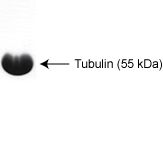Tubulin protein (>99% pure): porcine brain
Product Uses Include
- IC50 & EC50 determinations for anti-tubulin ligands.
- Microtubule binding studies
- Tubulin monomer binding studies
- HDAC6 studies
- Microtubule activated kinesin ATPase assays
Material
Tubulin protein has been purified from porcine brain by an adaptation of the method of Shelanski et al. (1), Further purification to >99% purity was achieved by cation exchange chromatography. Tubulin is supplied at 10 mg/ml as a frozen liquid in G-PEM (General tubulin buffer (Cat. # BST01) with 1 mM GTP (Cat. # BST06)).
This product is also available in a lyophilized, fully active format (Cat. # T240). The lyophilized format tubulin has many advantages over the frozen format. T240 costs less and since it allows for ambient temperature shipping, shipping is also significantly less costly. In addition, the lyophilized format allows for simpler (+4°C desiccated vs -70°C) and longer storage.
T238P is simular to T237 when 10% glycerol is added. >99% pure tubulin is also available in a convenient lyophilized pre-formed microtubule format (Cat. # MT002) for use in e.g. kinesin ATPase assays and microtubule binding studies.
Purity
Purity is determined by scanning densitometry of proteins on SDS-PAGE gels. Samples are >99% pure.

Figure 1: 100 µg of T238P was run on a 10% SDS-PAGE gel and stained with Coomassie Blue.
Biological Activity
The biological activity of T238P is assessed by a tubulin polymerization assay. The ability of tubulin to polymerize into microtubules is followed by observing an increase in optical density at 340nm (OD340 nm) of a tubulin solution. Under the experimental conditions defined below a 5 mg/ml tubulin solution in General tubulin buffer (Cat. # BST01) buffer plus 5% glycerol (Cat. # BST05) and 1 mM GTP (Cat. # BST06) should achieve an OD340 nm absorption reading between 0.75 - 1.10 in 30 min at 37°C. The assay volume is 180 ul and assumes a spectrophotometer pathlength of 0.8 cm. See Fig 2 on the TL238 datasheet page for an example of tubulin polymerization results.
It should be noted that tubulin minus glycerol WILL NOT polymerize in G-PEM buffer until very high tubulin concentrations (>10 mg/ml). Even at these concentrations polymerization is comparatively slow. Efficient polymerization at lower concentration of tubulin minus glycerol can be achieved by addition of a polymerization stimulating compound, e.g., paclitaxel or DMSO. See Figure 2 on the T237 product page for polymerization in the presence of glycerol and paclitaxel.
References
Shelanski, M. L., et al. (1973). Proc. Natl. Acad. Sci. USA. 70, 765-768
For product Datasheets and MSDSs please click on the PDF links below. For additional information, click on the FAQs tab above or contact our Technical Support department at tservice@cytoskeleton.com
Question 1: Under what conditions should I use tubulin prepared as a frozen liquid vs lyophilized powder?
Answer 1: Under most experimental conditions, we recommend using the lyophilized tubulin (Cat. # T240) as it offers improved storage and stability compared to the frozen liquid (Cat. # T238P) which must be stored at -70°C. Some researchers favor the frozen tubulin stock for high resolution microscopy studies and crystallography work.
Question 2: Are there special instructions for thawing and aliquoting Cat. # T238P ?
Answer 2: It is recommended that the frozen liquid tubulin (Cat. # T238P) be stored at -70°C, where it is stable for 6 months from the date of purchase. To use, the protein should be rapidly thawed in a room temperature water bath, immediately transferred to ice and aliquoted into “experiment sized” amounts. Snap freeze aliquots in liquid nitrogen and store at -70°C. Aliquots of T238P must be snap frozen in liquid nitrogen prior to storage at -70°C. Failure to do this results in significant loss of activity. Tubulin will be active for only 1 week if stored at -40°C.
Question 3: How does porcine tubulin compare to bovine tubulin?
Answer 3: Click here for an in-depth comparison of porcine and bovine tubulin.
If you have any questions concerning this product, please contact our Technical Service department at tservice@cytoskeleton.com



